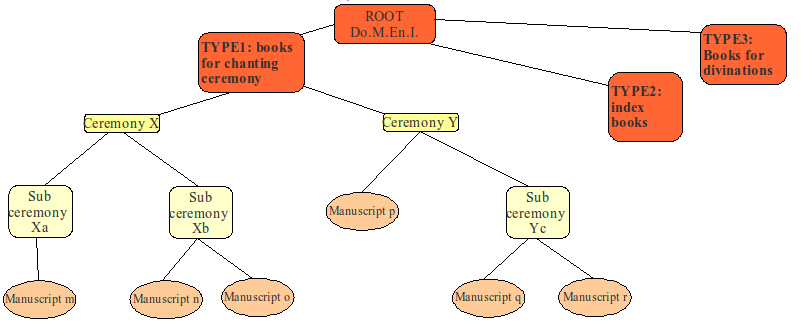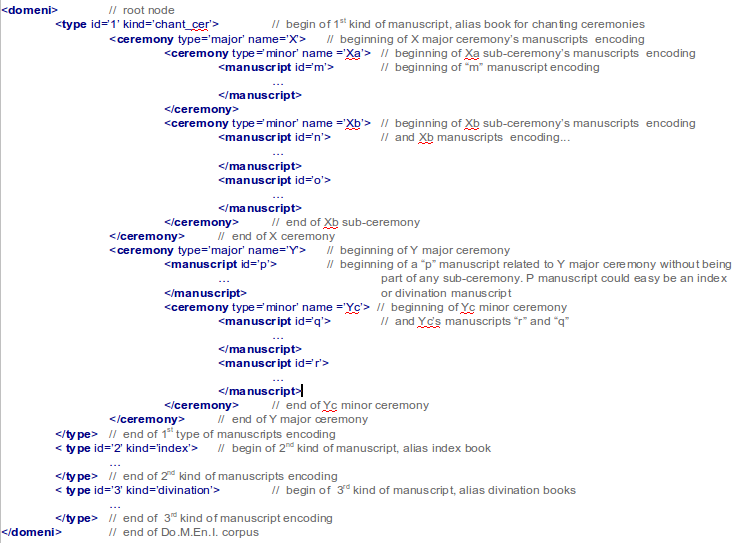please, browse with Mozilla Firefox
Intoduction and homepage of Dongba Manuscripts General Index, a census resource of Dongba manuscripts' world collections. (2009, 17th October)
intro page You're currently browsing here available as pdf


UNESCO recognized to Lijiang's scenery and city, Naxi people and culture, Dongba tradition and pictograph manuscripts literature as a part of the Human World Heritage.
According to UNESCO pictograph writing system and manuscripts pictograph art is one of peculiar CULTURAL EXPRESSION and ARTISTIC MANIFESTATION OF NAXI PEOPLE.
Pictograph writing system and Dongba literature are then Human Wold Heritage too, thus World Wide Web technology appears as one of the powerful instrument to render such human kind treasure enjoyable and available in whole world.
Diffusion of Dongba pictograph manuscript tradition is acculturation to Naxi people cultural richness and China ethnic variety.
Do.M.En.I. - Dongba Manuscript Encoding Initiative project originates and takes by applying to Dongba pictograph manuscript tradition study some digital humanities techonologies, and is focused about implementing an on-line resources enjoyable for Dongba manuscripts and Naxi pictograph literature.
Do.M.En.I. project target is thus focused about implementation of a growing and up-to-date open on-line archive of Dongba texts as annotated corpus, following L.C. and W3C standards recommendations.
Making up of Do.M.En.I. means also to struggle against some difficult factors as:
I feel just listed problems as incentive in hard-working for Do.M.En.I. implementation and realization.
World Wide web technology at today should be seen as the wider library to be consulted for information retrieval and documents browsing, especially in Academic world for exchanging of material and up-to-date information which run faster then every paper-publication or review.
Many digital humanities application is dedicated to texts browsing and documents retrieving, and cover large range of kind of information: from daily newspapers to linguistic annotated corpora or more specialized archives.
Plenty of digital texts and their extreme heterogeneity pushed W3C consortium (among other questions) to define some basic guidelines for digital encoding of texts: at today W3C recommends TEI standard for digital texts encoding.
Do.M.En.I. is a project of diffusion and acculturation about Dongba pictograph manuscript tradition and Naxi people culture, and in its intention of opening such cultural and artistic treasures both to all members of human kind and to academic world for further and deeper investigations, needs to accords with W3C standards.
Do.M.En.I. thus operates in double direction:
At today two are the only available on-line resources for Naxi pictograph manuscripts tradition, both displaying some tens of digital reproduction of manuscripts pages:
they both have heterogeneous standards for digital reproduction of manuscripts gathered by ceremony and/or by titles.
Moreover both corpora's manuscripts encoding stops to just to "0 level" of texts encoding (Lenci et al., 2005: 57), alias some sequences of images without any annotation.
Do.M.En.I. projects if focused about integration of such available sources, at first by making of:
making Do.M.En.I. an open for up-to-dating initiatives (other encoding levels, other reources integrations, manuscripts and group of manuscripts adding, etc...) playing for:
As introduced before Do.M.En.I. project consists in defining and implementing an encoding schema according to TEI and it work should be resumed in two focal targets:
For TEI standard recommendations please cfr official guideline: TEI – Text Encoding Initiative: http://www.tei-c.org
As introduced before Dongba manuscripts encoding in few words consists in projecting and implementing an useful encoding schema calibrated for Dongba manuscripts and according to TEI standards.
Among many excellent samples of calibrated encoding schema TEI accorded here is quoted ME.NO.T.A. - Medieval Nordic Text Archive http://www.menota.org, “a network of leading Nordic archives, libraries and research departments working with medieval texts and manuscript facsimiles. The aim of Menota is to preserve and publish medieval texts in digital form and to adapt and develop encoding standards necessary for this work. The archive will contain texts in the Nordic languages as well as in Latin.” (http://www.menota.org/index_en.page → 2009, June 27th )
Making treasure of ME.NO.T.A. some experiments about manuscripts encoding available as DRAFT-WORKS on www.xiulong.it:
As underlined uper, both are attempts, experiments! Made for firming-up of some drafts, all focused about ancient manuscripts study approaching by human technologies: Do.M.En.I. project springs also out from this drafts.
Do.M.En.I. ENCODING SCHEMA for Dongba manuscripts encoding ad Corpus making consists in:
Once decided what is needed to be marked-up and relative markers, thus porceeding with:
Implementation of Dongba manuscripts encoding schema is not limited or just related to creation of a TEXTS ENCODING INITIATIVE, but assuming a fundamental role of:
and considering OBJECTIVE DIFFERENCES AMONG
Encoding manuscripts operation also has to explicits:
One of the most distinctive features of Naxi culture is Dongba tradition and related pictographic texts: they are wrote in form of some thousands of manuscripts, and according to Jackson and Anshi (Oppitz M., Hsu E., 1998: 240) 5.118 manuscripts actually held in libraries of Europe and America:
Dongba pictographs manuscripts could be divided in three main kinds:
Jackson and Anshi study focused about style of manuscripts writing and schools of Naxi Dongba authors (ibid: 237 - 274) pointed out 5 main styles of writing manuscripts labeled as A,B,C,D and E style group:
A1: authors, who coincided with Rock’s Dto-la Dongba brothers, possessed very artistic skills, superior to common Dongba writer, with colored miniatures onto 1st page of manuscripts.
Most of the cover-titles were set in decorated frame on the top by draperies with a precious object in the middle as:
Iconographically associable also for incipits as:
A2: wrote by Dongba doted of very skilled artistic features: Jackson and Anshi states about Ho Ho-shou as the author, Dongba from the village of Nankow (Nankou Xin Cun, Naxi La’-ts’u wua) south-east of Lijiang
A3, coinciding with Rock’s He Huating Dongba, who taught Rock to read religious texts, also the drawer of pictographs in Rock’s dictionary and other publications.
He also wrote some title-pages and added them to some ritual manuscripts written by different hand.
A4 fine and neat drawings unique in character
A5 similar with A4, with neat drawings, but coinciding with Rock’s Dto dsu Dongba.
B group: presents more complicated pictures, and authors used more elaborated symbols for decorating title-pages; decorative draperies differs iconographically from A type.
According to Rock, manuscripts collected in B group were produced from Mun-shua-wua village, identified by Jackson and Anshi with Runanhua village of Tai’an township: they also divides B group in 9 sub-groups because of their iconography variety of decorations.
C group: C type presents titles very more elaborated that A and B, being decorated with six draperies, and among them Jackson and Anshi identified 7 different writers hands.
D group: they aren’t not sophisticated as those of A, B and C groups, with title-pages set side-way. Many of this manuscripts are divination books and mostly came from Baidi and Baoshan.
E group: presents non-elaborated title ornamentation, made by authors not as skilled as A, B, and C authors: Jackson and Anshi states they probably were novices.
Jackson and Anshi also studied style groups distributions and identified 4 main regional nucleus of manuscripts production, and they called them as “school”, alias focal centers of distribution of manuscripts:
Baisha: including Dongba of Lijiang plain, at today economic and cultural center of Naxi community. Baisha school appears to be specialized in production of book for chanting religious and ceremony, and they used to write both in pictographs and syllable-graphs.
According to Jackson & Anshi Baisha center comprises 5 mains areas in 2 or 3 miles around Lijiang:
Tai’an and Ludian
Tai’an township is south-west of Lijiang, expecially known for Dongba activities in Runanhua village. According to Dongba tradition, the founder of Dongba religion Shilo stayed for sometimes in a cave called “spiritual cave of Shilo” just in front of Runanhua village.
Such school included also:
Baidi: located in Sanba township of Zhongdian country, north of Lijiang, beyond Gold Sand River.
According to Naxi tradition, Shilo had his seat in Baidi itself: there’s a spiritual cave here dedicated to, and Baidi is considered to be the place of origin of Naxi/Dongba religion, infact it was a destination for a Dongba adepts to went here in pilgrimage in order to become Dongba masters.
Baidi’s manuscripts corpus didn’t include texts dedicated to the great ceremony Har-la-llu- k'o for suicides as in their rituals, Baidi’s Dongba didn’t perform sword dancing as they not use syllable-graphics.
Baoshan: school comprising townships of
all in the north of Lijiang, within the loop of the Gold Sand River.
Divination was very popular among Baoshan’s Dongbas, and they used to write – as Baidi’s Dongbas – only by pictographs.
From a L.C. point of view, Dongba pictographic manuscript literature is a perfect ecologic setting characterized by high verticality: manuscripts are infacts all about Dongba religion, thus such corpus is extremely SPECIALISTIC, or VERTICAL CORPUS, with:
In such vertical corpus previously introduced subdivision and classification of manuscripts by
represents basilar features which Do.M.En.I. has to reflect and represents in its texts encoding.
For instance, considering the 1
Thus Do.M.En.I. should reflects such organization, and has to be structured in a hierarchical succession of nodes and leafs

Diagram could well be reproduced in Xml well-formed tree:

Another level of mark-up apply-able to Do.M.En.I. corpus should describes bigger groups of ceremonies pooled by some common meta-features according and reflecting Dongba tradition, as i.ex.:
etc…
Moreover, another kind of featured mark-up of Dongba literature that Do.M.En.I. has to esplicits is about writing system used in manuscripts, distinguishing at among:
Resuming what previously stated, characteristics identified and projected a general guideline to define what's necessary for Do.M.En.I. implementation:
DoMEnI will adopt
![]()
Xiulong
Stefano Zamblera
2009, July 27